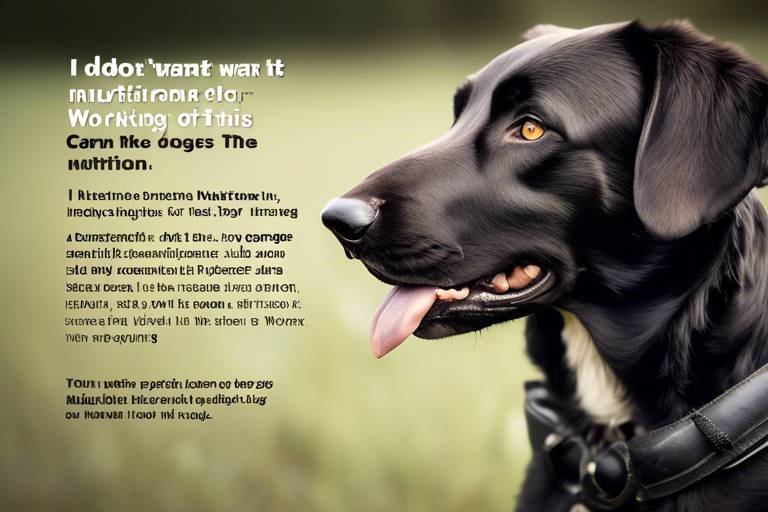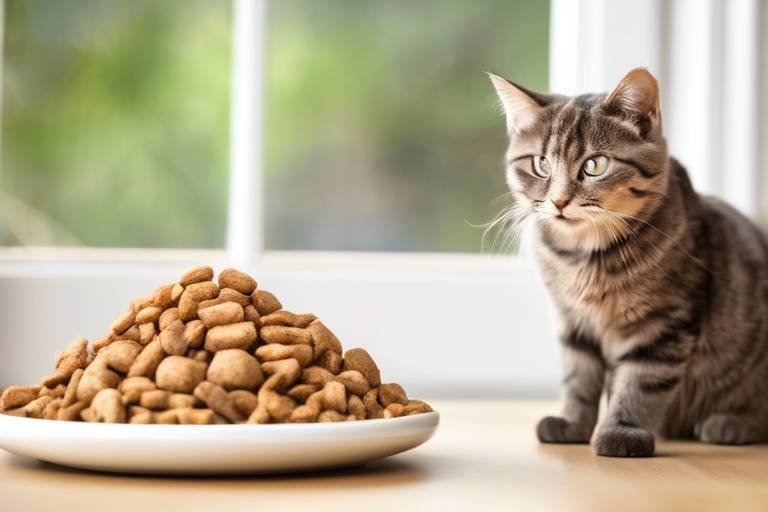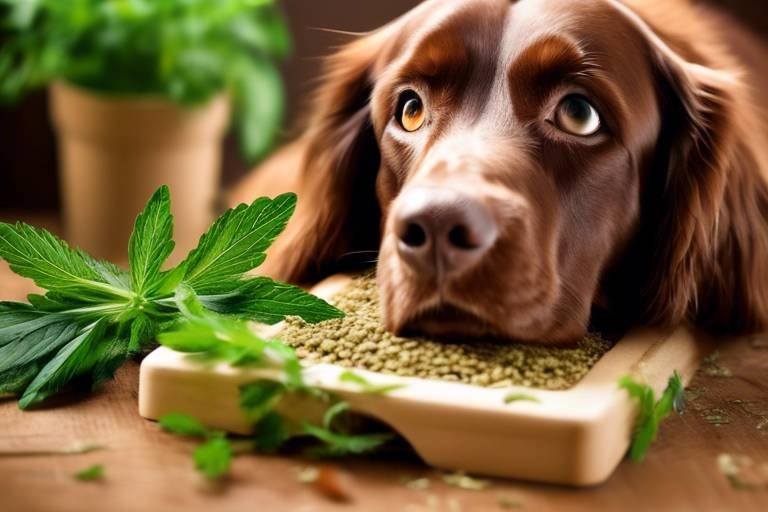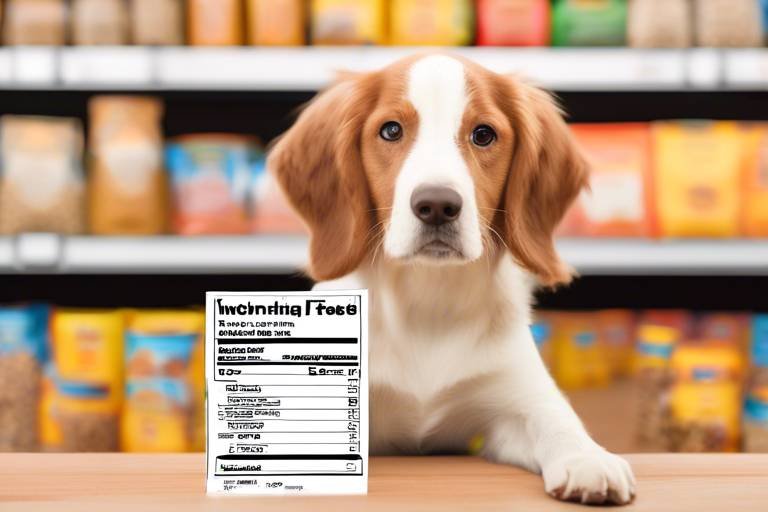How to Choose Foods for Pets with Sensitive Skin
Choosing the right foods for pets with sensitive skin can feel like navigating a minefield. With so many options available, it’s easy to get overwhelmed. But don’t worry! This guide will help you understand the ins and outs of selecting the best diet for your furry friend. Just like us, pets can suffer from skin issues that can lead to discomfort and irritation. So, what should you look for in their food? Well, it all starts with understanding their unique dietary needs.
First off, it’s essential to recognize that sensitive skin in pets can manifest in various ways. You might notice your pet scratching more than usual, or perhaps you see red patches on their skin. In some cases, you might even notice hair loss or dry, flaky skin. These symptoms can be signs of underlying issues, which often lead back to diet. That’s why selecting the right food is crucial—not just for their skin, but for their overall health.
When it comes to food, the ingredients play a significant role. Look for high-quality proteins, healthy fats, and a balance of carbohydrates. Ingredients like chicken, turkey, or fish are often better tolerated than beef or dairy, which are common allergens. Additionally, consider foods that contain omega-3 and omega-6 fatty acids, as these can help improve skin health and reduce inflammation. Think of these nutrients as a soothing balm for your pet's skin!
Another important factor is the presence of fillers and artificial additives. Many commercial pet foods contain ingredients that can irritate sensitive skin, such as artificial colors, flavors, and preservatives. Always check the label and steer clear of products that list these ingredients. Instead, opt for natural, whole-food ingredients that support your pet’s health. Remember, you wouldn’t want to feed your pet something that you wouldn’t eat yourself, right?
In summary, choosing the right food for pets with sensitive skin involves a careful examination of ingredients, an understanding of their dietary needs, and a commitment to providing them with the best possible nutrition. By making informed choices, you can help alleviate their discomfort and promote healthier skin. Now, let’s dive deeper into the specifics of identifying food allergies and hypoallergenic options in the next sections!
- What are the signs of sensitive skin in pets?
Common signs include itching, redness, irritation, and hair loss. If you notice any of these symptoms, it might be time to reassess their diet.
- How can I identify food allergies in my pet?
Look for gastrointestinal issues and skin reactions. An elimination diet can help pinpoint specific allergens.
- What should I look for in hypoallergenic pet foods?
Choose foods with limited ingredients, high-quality proteins, and no fillers or artificial additives.
- Is it necessary to consult a veterinarian?
Absolutely! A vet can provide personalized recommendations and ensure that dietary changes are safe and beneficial.

Understanding Sensitive Skin in Pets
This article provides guidance on selecting the right foods for pets suffering from sensitive skin, focusing on ingredients, dietary needs, and tips for improving their overall health.
Sensitive skin in pets can be a real challenge for both the furry friends and their owners. Imagine your pet constantly scratching, biting, or licking at their skin, leaving you feeling helpless and concerned. Sensitive skin can manifest in various ways, including itching, redness, and even irritation. It's essential to recognize these symptoms early on, as they can lead to more severe health issues if left unaddressed.
But what causes this sensitivity? There are several factors that can contribute to your pet's skin problems. Environmental allergens such as pollen, dust mites, and mold can irritate their skin. Additionally, certain ingredients in their food can trigger reactions. Understanding the root causes of sensitive skin is crucial for selecting the right food that not only alleviates discomfort but also promotes overall skin health.
When it comes to sensitive skin, it's not just about the surface symptoms. The skin is the largest organ of the body and plays a vital role in your pet's overall health. A compromised skin barrier can lead to infections, increased itchiness, and a lower quality of life. Therefore, addressing the issue holistically is key. This means not only focusing on diet but also considering other factors such as grooming, bathing practices, and environmental control.
Did you know that some pets are more prone to sensitive skin than others? Breeds like Bulldogs, West Highland White Terriers, and Cocker Spaniels often experience skin sensitivities more than others. However, any pet can develop issues, regardless of breed. That's why it’s important to observe your pet closely and consult with a veterinarian if you notice any concerning signs.
In conclusion, understanding sensitive skin in pets is a multi-faceted issue that requires attention and action. By recognizing the symptoms, identifying potential allergens, and making informed dietary choices, you can significantly improve your pet's quality of life. Remember, a happy pet is a healthy pet!
Food allergies are common culprits of sensitive skin. Understanding how to identify potential allergens in your pet's diet is essential for making informed choices that support their well-being.
Certain ingredients, such as beef, dairy, and grains, are frequent allergens. Learning about these ingredients helps pet owners make better dietary decisions for their pets with sensitive skin.
Recognizing the signs of food allergies, including gastrointestinal issues and skin reactions, can help you determine if your pet's diet needs adjustment for improved comfort.
Conducting an elimination diet can help identify specific food allergies. This method involves removing potential allergens and gradually reintroducing them to pinpoint the triggers.
Hypoallergenic pet foods are designed to minimize allergic reactions. Understanding their benefits and how they can support pets with sensitive skin is essential for making the right choice.
Consulting a veterinarian is crucial when addressing sensitive skin issues in pets. They can provide tailored recommendations based on your pet's unique needs and health status.
Veterinary guidance ensures that dietary changes are safe and effective. A vet can help identify underlying health issues contributing to skin sensitivity, leading to better dietary choices.
Regular veterinary check-ups allow for ongoing monitoring of your pet's skin condition. This proactive approach helps ensure that dietary adjustments remain effective and beneficial over time.
In addition to diet, various skin care practices can enhance your pet's comfort. These include regular grooming, bathing with appropriate shampoos, and maintaining a clean living environment.
- What are the signs of sensitive skin in pets? Look for itching, redness, and irritation.
- Can food allergies cause skin problems? Yes, certain food ingredients can trigger allergic reactions leading to skin issues.
- What should I do if I suspect my pet has a food allergy? Consider an elimination diet and consult your veterinarian for guidance.
- Are hypoallergenic pet foods effective? They can be beneficial for pets with sensitivities, but it's essential to choose the right one.
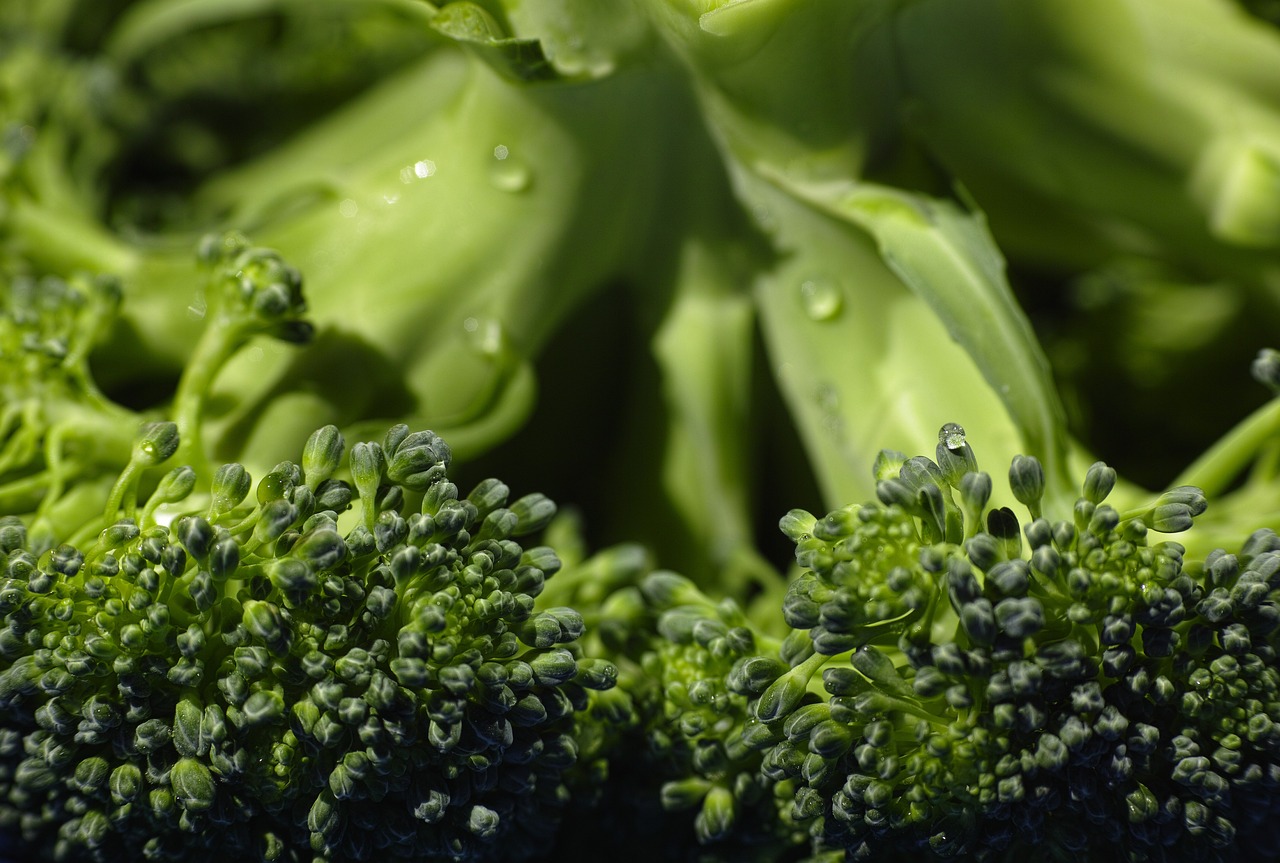
Identifying Food Allergies
When it comes to our furry friends, food allergies can be tricky to identify, yet they play a significant role in their overall comfort and health. Just like humans, pets can have adverse reactions to certain foods, leading to a variety of symptoms that may not always be obvious. You might be wondering, "How do I know if my pet has a food allergy?" Well, it's essential to pay close attention to their behavior and physical condition.
First and foremost, look for signs that indicate your pet might be experiencing discomfort. Common symptoms of food allergies include:
- Itching and scratching: If your pet is constantly scratching or biting at their skin, it could be a sign of an allergy.
- Redness or inflammation: Areas of the skin may appear red or swollen, indicating irritation.
- Gastrointestinal issues: Diarrhea, vomiting, or gas can also signal food allergies.
Recognizing these symptoms is the first step. However, understanding the underlying causes is just as crucial. Food allergies in pets typically stem from their diet. Certain ingredients can trigger an immune response, leading to the discomfort you observe. The most common allergens include:
| Common Allergens | Description |
|---|---|
| Beef | A prevalent protein source that many pets can be sensitive to. |
| Dairy | Some pets lack the enzyme needed to digest lactose, leading to allergic reactions. |
| Wheat and grains | These ingredients can cause digestive issues and skin problems in sensitive pets. |
| Chicken | Another common protein that can trigger allergies in some dogs and cats. |
Now that we know what to look for, how do we pinpoint the specific allergens affecting your pet? One effective method is the elimination diet. This process involves removing suspected allergens from your pet's diet for a period of time, usually around 8 to 12 weeks. During this time, you'll monitor your pet's symptoms closely. If you notice an improvement, you can then gradually reintroduce the eliminated foods one at a time. This way, you can identify which specific ingredient is causing the allergic reaction.
It's important to note that this process requires patience and diligence. Keeping a detailed diary of your pet's diet and symptoms can be immensely helpful. If you're unsure or if your pet's condition worsens, it's always best to consult with a veterinarian for professional guidance.
In summary, identifying food allergies in pets is a critical step towards improving their quality of life. By recognizing the signs, understanding common allergens, and implementing an elimination diet, you can help your furry friend feel better and enjoy a happier, healthier life.
Common Allergens in Pet Foods
When it comes to our furry friends, understanding the common allergens in their food is crucial for managing sensitive skin. Many pet owners are surprised to learn that their beloved companions can have adverse reactions to certain ingredients, which can lead to discomfort and health issues. The most frequent allergens found in pet foods include beef, dairy, chicken, grains, and soy.
To elaborate, beef is often a leading cause of allergies in dogs and cats alike. While it’s a popular protein source, many pets can develop sensitivities to it over time. Similarly, dairy products, which may seem harmless, can cause gastrointestinal upset in pets that lack the enzyme needed to digest lactose. Chicken, another common ingredient, can also trigger allergies in some pets, making it essential to monitor your pet’s reactions closely.
Grains like wheat and corn are frequently included in many commercial pet foods but are also known to be problematic for pets with sensitive systems. These ingredients can lead to skin irritations and digestive issues. Lastly, soy, often used as a filler in pet foods, can also cause allergic reactions in some animals. Understanding these common allergens can help pet owners make informed choices when selecting a diet for their pets.
It’s important to note that not all pets will react to these ingredients, but if your pet exhibits symptoms such as itching, redness, or even gastrointestinal disturbances, it might be time to consider a diet change. Always consult with your veterinarian before making significant changes to ensure that your pet's nutritional needs are met while avoiding potential allergens.
In summary, being aware of the common allergens in pet foods is an essential step in managing your pet's sensitive skin. By keeping an eye on the ingredients in their diet and recognizing any adverse reactions, you can help your pet live a more comfortable and healthy life.
- What are the signs of food allergies in pets? Symptoms may include itching, redness, gastrointestinal issues, and changes in behavior.
- How can I identify my pet's food allergies? An elimination diet is often recommended to pinpoint specific allergens.
- Are hypoallergenic pet foods effective? Yes, hypoallergenic foods are designed to minimize allergic reactions and can be beneficial for pets with sensitive skin.
- Should I consult a veterinarian before changing my pet's diet? Absolutely! A vet can provide tailored advice based on your pet's health status.
Signs of Food Allergies
Identifying the signs of food allergies in your pet can feel like trying to solve a mystery. It’s essential to be vigilant and observant because these signs can manifest in various ways. The most common symptoms include itching, which can lead to excessive scratching, biting, or licking of the skin. This behavior often results in red, inflamed patches that can become infected if left untreated. You might also notice your pet has developed hair loss in certain areas, particularly where they tend to scratch or chew the most.
In addition to skin issues, food allergies can also trigger gastrointestinal problems. Symptoms such as vomiting, diarrhea, or flatulence can be alarming and often lead pet owners to believe their furry friend has a stomach bug. However, these digestive issues can be closely linked to the foods they are consuming. It’s crucial to connect the dots between dietary habits and these health concerns.
To help you better understand the signs of food allergies, here’s a quick reference table:
| Symptoms | Description |
|---|---|
| Itching | Persistent scratching or licking leading to skin irritation |
| Redness | Inflamed skin patches that may appear raw or irritated |
| Hair Loss | Bald patches often associated with excessive grooming |
| Gastrointestinal Issues | Vomiting, diarrhea, or excessive gas |
It’s also worth noting that some pets may exhibit ear infections or chronic ear problems due to food allergies. If your pet frequently shakes their head or scratches at their ears, it might be time to investigate their diet. This is especially true if these symptoms are coupled with the skin issues mentioned earlier.
Overall, being proactive and observant is key. If you suspect your pet may have food allergies, keeping a journal of their symptoms and any changes in their diet can be immensely helpful. This information will be invaluable when discussing your concerns with a veterinarian. Remember, early detection and intervention can lead to a happier, healthier pet!
Q: How can I tell if my pet has a food allergy?
A: Look for signs such as itching, redness, hair loss, or gastrointestinal issues. Keeping track of their symptoms and diet can help identify potential allergens.
Q: Can food allergies develop suddenly in pets?
A: Yes, pets can develop food allergies at any age, even if they have been eating the same food for years.
Q: What should I do if I suspect my pet has a food allergy?
A: Consult your veterinarian for advice on conducting an elimination diet and other diagnostic tests to identify the specific allergens.
Q: Are hypoallergenic pet foods effective?
A: Hypoallergenic foods can be effective for many pets with sensitive skin, as they are formulated to minimize allergic reactions. However, it’s essential to consult with your vet to find the right option for your pet.
Testing for Allergies
When it comes to understanding your pet's sensitive skin, is a vital step that can lead to significant improvements in their comfort and overall health. The most effective way to identify food allergies is through an elimination diet. This method requires you to remove any potential allergens from your pet's diet for a certain period, typically around 8 to 12 weeks. During this time, you should carefully observe your pet for any changes in their skin condition or behavior.
Once the elimination phase is complete, you can begin to reintroduce foods one at a time. This gradual process allows you to pinpoint which specific ingredients may be causing the allergic reactions. For example, if you start with a novel protein source like duck or fish, and your pet's skin improves, it may indicate that they are allergic to more common proteins like chicken or beef.
It's essential to keep a detailed food diary during this process. Documenting everything your pet eats, along with any changes in their skin condition, can provide valuable insights. This record can also be beneficial when consulting with your veterinarian, who can help interpret the results and suggest the next steps.
Here’s a quick overview of the elimination diet process:
| Phase | Description |
|---|---|
| Elimination Phase | Remove all potential allergens from your pet's diet for 8-12 weeks. |
| Reintroduction Phase | Gradually add one ingredient at a time and monitor for reactions. |
| Observation | Keep a food diary to track changes in skin condition and overall health. |
It's important to note that not all pets will react the same way to certain foods, and some may not show immediate signs of an allergy. Therefore, patience is key during this testing phase. If your pet exhibits severe symptoms, such as excessive itching or swelling, it's crucial to consult your veterinarian immediately.
Remember, the goal of this testing is to find a balanced diet that supports your pet's skin health while also ensuring they receive all the necessary nutrients. By understanding your pet's specific needs, you can help them lead a more comfortable and happy life.
- How long does the elimination diet take? The elimination diet typically lasts between 8 to 12 weeks, depending on how quickly you observe changes in your pet's condition.
- Can I use commercial hypoallergenic diets? Yes, many commercial diets are formulated to be hypoallergenic, but it's best to consult your veterinarian before making any changes.
- What if my pet has multiple allergies? If multiple allergies are suspected, a veterinarian can help create a tailored diet plan that avoids all allergens while still providing balanced nutrition.
Choosing Hypoallergenic Pet Foods
When it comes to selecting the right food for pets with sensitive skin, hypoallergenic pet foods can be a game-changer. These specially formulated diets are designed to reduce the likelihood of allergic reactions, which can lead to discomfort and skin issues. But what exactly makes a food hypoallergenic? In simple terms, hypoallergenic foods are made with limited ingredients or use proteins and carbohydrates that are less likely to trigger allergies. This means they often contain novel protein sources, such as duck, venison, or fish, which your pet may not have been exposed to before. By introducing these alternatives, you can help your furry friend find relief from the irritations caused by common allergens.
One of the key benefits of hypoallergenic diets is their ability to promote better digestive health. Many pets with sensitive skin also suffer from gastrointestinal issues, and hypoallergenic foods often include easily digestible ingredients that can help alleviate these problems. When choosing a hypoallergenic food, look for options that list the protein source as the first ingredient and avoid fillers like corn, soy, or artificial additives. A good rule of thumb is to read the ingredient label carefully and choose brands that prioritize quality and transparency.
It's important to note that transitioning your pet to a hypoallergenic diet should be done gradually. Abrupt changes can lead to digestive upset, which is the last thing you want when trying to improve your pet's skin condition. Start by mixing a small amount of the new food with your pet's current diet, and gradually increase the proportion over a week or two. This slow transition helps your pet's digestive system adjust while allowing you to monitor any changes in their skin condition.
Before making any significant changes to your pet's diet, it's wise to consult with a veterinarian. They can help you choose the right hypoallergenic food based on your pet's specific needs and may even recommend a particular brand that has worked well for other pets with similar issues. Additionally, keep in mind that while hypoallergenic foods can be beneficial, they are not a cure-all. Ongoing monitoring of your pet's skin condition and overall health is essential to ensure that the chosen diet continues to meet their needs.
In summary, choosing hypoallergenic pet foods is a proactive step towards ensuring your pet's comfort and well-being. By selecting high-quality, limited-ingredient diets tailored for sensitive skin, you can help your pet lead a happier, healthier life. Remember, every pet is unique, so what works for one might not work for another. Stay observant, be patient during the transition, and consult with your vet for the best results.
- What are the signs that my pet might have a food allergy? Look for symptoms such as itching, redness, gastrointestinal upset, or unusual behavior after eating.
- How long does it take to see improvements after switching to hypoallergenic food? Many pet owners notice improvements within a few weeks, but it can take longer depending on the individual pet and the severity of their allergies.
- Can I make homemade hypoallergenic food for my pet? Yes, but it's crucial to consult with a veterinarian to ensure that your homemade diet meets all of your pet's nutritional needs.
- Are all hypoallergenic pet foods the same? No, different brands and formulations can vary significantly in ingredients and quality. Always read labels and choose reputable brands.

Consulting with a Veterinarian
When it comes to addressing sensitive skin issues in our beloved pets, consulting a veterinarian is not just a good idea—it's essential. Think of your veterinarian as your pet's personal health coach, equipped with the knowledge and tools necessary to tackle skin sensitivities effectively. They can provide tailored recommendations based on your pet's unique needs and health status, ensuring that any dietary changes you consider are both safe and effective.
One of the primary reasons to seek professional guidance is that a veterinarian can help identify underlying health issues that may contribute to your pet's skin sensitivity. For instance, certain conditions like hypothyroidism or parasites can mimic or exacerbate skin problems. By understanding the root cause, you can make informed decisions about food and care that can lead to significant improvements in your pet's well-being.
Moreover, regular veterinary check-ups are crucial for ongoing monitoring of your pet's skin condition. During these visits, your vet can assess whether the current dietary interventions are effective or if adjustments are necessary. This proactive approach not only enhances your pet's comfort but also helps prevent potential complications that could arise from neglected skin issues.
In addition to dietary advice, veterinarians can recommend specific products or treatments that can aid in managing your pet's sensitive skin. This might include medicated shampoos, topical treatments, or even supplements designed to improve skin health. The combination of a well-planned diet and appropriate skin care can work wonders in alleviating discomfort.
Ultimately, the journey to improving your pet's skin health doesn't have to be a lonely one. With the right veterinary support, you can navigate the complexities of food allergies and sensitivities, ensuring your furry friend leads a happy, healthy life. So, don't hesitate to schedule that appointment—your pet's skin will thank you!
- How often should I take my pet to the vet for skin issues? It's recommended to have regular check-ups every 6 to 12 months, but more frequent visits may be necessary if your pet has ongoing skin problems.
- Can I try home remedies for my pet's sensitive skin? While some home remedies can be beneficial, it's essential to consult your vet before trying anything new to avoid potential harm.
- What should I do if my pet's skin condition worsens? If you notice increased redness, swelling, or discomfort, contact your veterinarian immediately for advice.
Importance of Professional Guidance
When it comes to managing your pet's sensitive skin, professional guidance is invaluable. Just like how we wouldn't attempt to fix a complex car issue without a mechanic, navigating the world of pet nutrition and skin health is best done with the help of a veterinarian. These professionals are equipped with the knowledge and tools to tailor a dietary plan that suits your pet's individual needs. They can identify underlying health issues that may be exacerbating skin sensitivity, which you might not even notice as a pet owner.
Moreover, a veterinarian can help you understand the specific nutrients your pet requires. For example, omega-3 fatty acids are known for their anti-inflammatory properties and can significantly improve skin health. But how do you know if your pet is getting enough? That's where your vet comes in. They can recommend the right supplements or food options that are rich in these essential fatty acids.
Additionally, regular consultations with your vet ensure that any dietary changes are not only effective but safe for your pet. Pets can have unique reactions to different foods, and what works for one might not work for another. A veterinarian can monitor your pet's progress, adjusting their diet as needed to ensure optimal health. This ongoing relationship can be a game-changer, providing peace of mind that you're doing everything possible to help your furry friend.
In summary, here are some key reasons why seeking professional guidance is crucial:
- Tailored Recommendations: Vets can provide specific dietary advice based on your pet's health status.
- Identification of Underlying Issues: They can uncover health problems that contribute to skin sensitivity.
- Monitoring and Adjustments: Regular check-ups allow for timely dietary adjustments.
So, don't hesitate to reach out to your veterinarian. They are your best ally in ensuring your pet's comfort and health, especially when dealing with sensitive skin issues.
Q1: How can I tell if my pet has sensitive skin?
A1: Look for signs such as itching, redness, and irritation. If your pet is frequently scratching or licking, it may indicate sensitive skin.
Q2: Can I change my pet's diet without consulting a vet?
A2: While you can make changes, it's best to consult a vet to ensure the new diet meets your pet's nutritional needs and doesn't exacerbate any existing issues.
Q3: What are some hypoallergenic foods I can try?
A3: Hypoallergenic options often include novel protein sources like duck or venison and grain-free formulas. Your vet can recommend specific brands.
Q4: How often should I take my pet to the vet for skin issues?
A4: Regular check-ups are recommended, especially if your pet has ongoing skin problems. Your vet can provide a schedule based on your pet's condition.
Regular Check-ups and Monitoring
When it comes to ensuring the well-being of our furry friends, regular check-ups and monitoring are absolutely essential. Think of it as a routine pit stop for your pet; just like a car needs maintenance to run smoothly, your pet requires consistent veterinary care to stay healthy. During these check-ups, your veterinarian can evaluate your pet’s skin condition, assess any changes, and adjust dietary recommendations as needed. This proactive approach not only helps in managing sensitive skin but also in identifying any underlying health issues that might be contributing to discomfort.
It's important to remember that sensitive skin can be a symptom of various health conditions, ranging from allergies to more serious issues. By keeping a close eye on your pet’s skin health, you can catch potential problems early on. For instance, if you notice increased itching or redness, it’s time to schedule a visit to the vet. Regular monitoring allows you to track any changes in your pet's skin condition, which can be crucial for effective treatment.
Moreover, during these visits, your vet can provide valuable insights into your pet’s overall health and well-being. They might suggest specific tests or treatments tailored to your pet's unique needs. For instance, if your pet shows signs of food allergies, the vet may recommend skin tests or blood tests to pinpoint the exact allergens. This way, you can make informed decisions about your pet's diet and care.
To make the most of your veterinary visits, consider keeping a health journal for your pet. Document any changes you observe in their skin condition, behavior, or diet. This information can be incredibly helpful for your vet in diagnosing issues and formulating a treatment plan. Additionally, be sure to ask questions during your appointments; after all, you are your pet’s best advocate!
In summary, regular veterinary check-ups and monitoring are key components in managing your pet's sensitive skin. They not only help in adjusting dietary needs but also ensure that your pet remains happy and healthy. Remember, a little proactive care goes a long way in enhancing your pet's quality of life.
- How often should I take my pet for check-ups? It's generally recommended to take your pet for a check-up at least once a year, but more frequent visits may be necessary for pets with sensitive skin or other health issues.
- What should I do if I notice changes in my pet's skin? If you see any signs of irritation, redness, or excessive itching, it's best to consult your veterinarian as soon as possible.
- Can I treat my pet’s sensitive skin at home? While some home remedies can provide relief, it's crucial to consult your vet for a proper diagnosis and treatment plan tailored to your pet's needs.
- Are there specific foods that can help with sensitive skin? Yes, hypoallergenic pet foods and those with limited ingredients are often recommended for pets with sensitive skin.

Additional Skin Care Tips
This article provides guidance on selecting the right foods for pets suffering from sensitive skin, focusing on ingredients, dietary needs, and tips for improving their overall health.
Sensitive skin in pets can manifest as itching, redness, or irritation. Recognizing the symptoms and causes is crucial for selecting appropriate food that alleviates discomfort and promotes skin health.
Food allergies are common culprits of sensitive skin. Understanding how to identify potential allergens in your pet's diet is essential for making informed choices that support their well-being.
Certain ingredients, such as beef, dairy, and grains, are frequent allergens. Learning about these ingredients helps pet owners make better dietary decisions for their pets with sensitive skin.
Recognizing the signs of food allergies, including gastrointestinal issues and skin reactions, can help you determine if your pet's diet needs adjustment for improved comfort.
Conducting an elimination diet can help identify specific food allergies. This method involves removing potential allergens and gradually reintroducing them to pinpoint the triggers.
Hypoallergenic pet foods are designed to minimize allergic reactions. Understanding their benefits and how they can support pets with sensitive skin is essential for making the right choice.
Consulting a veterinarian is crucial when addressing sensitive skin issues in pets. They can provide tailored recommendations based on your pet's unique needs and health status.
Veterinary guidance ensures that dietary changes are safe and effective. A vet can help identify underlying health issues contributing to skin sensitivity, leading to better dietary choices.
Regular veterinary check-ups allow for ongoing monitoring of your pet's skin condition. This proactive approach helps ensure that dietary adjustments remain effective and beneficial over time.
In addition to diet, various skin care practices can enhance your pet's comfort. Regular grooming is crucial; it helps remove loose fur and dander, which can irritate sensitive skin. Consider using a gentle brush designed for your pet's coat type, as this can stimulate the skin and distribute natural oils, promoting a healthier coat.
Bathing your pet with appropriate shampoos is another essential aspect of skin care. Look for hypoallergenic shampoos that are free from harsh chemicals and fragrances. These products can help soothe the skin and prevent further irritation. Also, be mindful of the frequency of baths; over-bathing can strip the skin of its natural oils, leading to dryness and discomfort.
Maintaining a clean living environment is equally important. Regularly washing your pet's bedding and toys can reduce allergens and irritants. Vacuuming your home frequently will help remove dust, dander, and other potential skin irritants. Consider using an air purifier to improve air quality, as this can also benefit your pet's skin health.
Lastly, don't forget about hydration! Ensure your pet has access to fresh, clean water at all times. Proper hydration supports skin health and overall well-being. You might even want to explore adding omega-3 fatty acids to their diet, as these can promote healthy skin and a shiny coat.
Q: How can I tell if my pet has sensitive skin?
A: Look for signs like excessive itching, redness, or irritation. If your pet is scratching more than usual or has bald patches, it may indicate sensitive skin.
Q: Can I use human shampoos on my pet?
A: It's best to avoid using human shampoos on pets, as they can contain ingredients that may irritate their skin. Always opt for pet-specific products.
Q: What should I do if my pet's skin condition worsens?
A: If you notice any worsening symptoms, consult your veterinarian immediately. They can assess your pet's condition and recommend appropriate treatments.
Q: How long does it take to see improvements in my pet's skin condition?
A: It can vary depending on the individual pet and the underlying cause. Generally, you should start to see improvements within a few weeks of dietary changes or treatments.
Frequently Asked Questions
-
What are the common signs of sensitive skin in pets?
Sensitive skin in pets can show up as itching, redness, or irritation. You might notice your furry friend scratching more than usual or licking certain areas of their body. If their skin looks inflamed or they seem uncomfortable, it’s a good idea to investigate further.
-
How can I identify food allergies in my pet?
Identifying food allergies involves observing your pet’s reactions after eating. Common signs include gastrointestinal issues like vomiting or diarrhea, as well as skin reactions such as rashes or excessive scratching. Keeping a food diary can help you track what they've eaten and any symptoms that follow.
-
What are some common allergens found in pet foods?
Some of the most frequent allergens in pet foods include beef, dairy, chicken, and grains. If your pet has sensitive skin, it's wise to read labels carefully and consider avoiding these ingredients to see if their condition improves.
-
What is a hypoallergenic diet, and how can it help my pet?
A hypoallergenic diet is specially formulated to reduce the risk of allergic reactions. These foods often contain novel proteins and limited ingredients, making them easier for sensitive pets to digest. Switching to a hypoallergenic diet can help alleviate skin issues and improve your pet's overall well-being.
-
Why is it important to consult a veterinarian?
Consulting a veterinarian is crucial because they can provide tailored advice based on your pet’s specific health needs. They can help identify underlying issues that may be causing skin sensitivity and recommend appropriate dietary changes that ensure your pet stays healthy and happy.
-
How often should I take my pet for check-ups?
Regular veterinary check-ups are important, ideally every six months. These visits allow the vet to monitor your pet’s skin condition and make necessary dietary adjustments over time. This proactive approach can prevent potential health issues and keep your pet comfortable.
-
Are there additional care tips for pets with sensitive skin?
Absolutely! In addition to a proper diet, regular grooming and bathing with suitable shampoos can make a huge difference. Keeping your pet’s living environment clean and free from allergens also contributes to their skin health and overall comfort.







